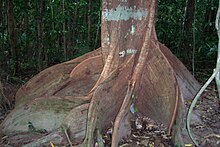Dysoxylum pettigrewianum
| Spur mahogany | |
|---|---|

| |
| Daintree National Park, Australia | |
| Scientific classification | |
| Kingdom: | Plantae |
| Clade: | Tracheophytes |
| Clade: | Angiosperms |
| Clade: | Eudicots |
| Clade: | Rosids |
| Order: | Sapindales |
| Family: | Meliaceae |
| Genus: | Dysoxylum |
| Species: | D. pettigrewianum
|
| Binomial name | |
| Dysoxylum pettigrewianum | |
Dysoxylum pettigrewianum, commonly known as spur mahogany, spurwood, or Cairns satinwood is a species of large tropical rainforest tree in the family Meliaceae found in Queensland, New Guinea, Solomon Islands and Malesia. In Queensland it is found in the wet tropics from Rossville near Cooktown in the north, southwards to Tully.[3]
The species was first described in 1892 by the colonial botanist of Queensland Frederick Manson Bailey. Common names include spurwood, Cairns satinwood and spur mahogany.[4] The species name honours William Pettigrew. It is a member of the large tropical genus Dysoxylum, many of which are large rainforest trees.[5]
Known for the prominent protrusions on the trunk buttresses, it may reach in excess of 35 metres (100 ft) tall,[6] with a spreading canopy up to 15 m (50 ft). The warty bark is dark brown,[5] and the red/brown timber has a pleasant fragrance. The compound leaves have between 7 and 15 overlapping leaflets.[6] The tree can be deciduous in winter dry spells. Appearing in January, the small yellow flowers are bell-shaped and have a diameter of around 1.2 cm (0.5 in). These are followed by the pear-shaped fruit which contain four seeds and ripen in November.[5] The orange/brown warty fruits are eaten by cassowaries and metallic starlings,[6] and the leaves eaten by Lumholtz's tree-kangaroo.[7]
Dysoxylum pettigrewianum grows in lowland rainforest up to an altitude of 800 m (2500 ft).[3] Growing too large for the average garden, Dysoxylum pettigrewianum is suitable for planting in parks and public gardens, making a useful shade tree. Young plants need shelter, and the species does best in a well-drained acidic soil.[5]
References[]
| Wikimedia Commons has media related to Dysoxylum pettigrewianum. |
- ^ "Species profile—Dysoxylum pettigrewianum". Queensland Department of Environment and Science. Queensland Government. Retrieved 11 June 2021.
- ^ "Dysoxylum pettigrewianum". International Plant Names Index (IPNI) (2021). Royal Botanic Gardens, Kew. Retrieved 11 June 2021.
- ^ Jump up to: a b F.A.Zich; B.P.M.Hyland; T.Whiffen; R.A.Kerrigan (2020). "Dysoxylum pettigrewianum". Australian Tropical Rainforest Plants Edition 8 (RFK8). Centre for Australian National Biodiversity Research (CANBR), Australian Government. Retrieved 11 June 2021.
- ^ "Dysoxylum pettigrewianum F.M.Bailey". Australian Plant Name Index (APNI), IBIS database. Centre for Plant Biodiversity Research, Australian Government.
- ^ Jump up to: a b c d Elliot RW, Jones DL, Blake T (1984). Encyclopaedia of Australian Plants Suitable for Cultivation:Volume 3 - Ce-Er. Port Melbourne: Lothian Press. p. 377. ISBN 0-85091-167-2.
- ^ Jump up to: a b c Beasley, John (2006) Plants of Tropical Queensland: the compact guide, Footloose Publications; page 104. ISBN 1-876617-13-6
- ^ Martin, Roger William (2005). Tree-kangaroos of Australia and New Guinea. Collingwood, Victoria: CSIRO Publishing. p. 43. ISBN 0-643-09072-X.
- Nature Conservation Act least concern biota
- Dysoxylum
- Flora of Queensland
- Flora of New Guinea
- Flora of Malesia
- Trees of the Solomon Islands
- Trees of Australia
- Sapindales of Australia
- Plants described in 1892